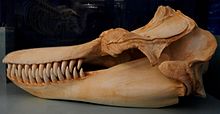Gnathostomata
| Gnathostomata Temporal range: Late Ordovician - Recent
| |
|---|---|

| |
| Gnathostomata are jawed vertebrates | |
| Scientific classification | |
| Domain: | Eukaryota |
| Kingdom: | Animalia |
| Phylum: | Chordata |
| Subphylum: | Vertebrata |
| Infraphylum: | Gnathostomata Gegenbaur, 1874[1] |
| Subgroups | |
|
Placodermi † | |
Gnathostomata (Template:Pron-en) is the group of vertebrates with jaws. The term derives from Greek γνάθος (gnathos) "jaw" + στόμα (stoma) "mouth". In addition to opposing jaws, living gnathostomes also have teeth, paired appendages, and a horizontal semicircular canal of the inner ear, along with many other distinguishing characteristics.
The group is traditionally a superclass, broken into three top-level groupings: Chondrichthyes, or the cartilaginous fish; Placodermi, an extinct clade of armored fish; and Teleostomi, which includes the familiar classes of bony fish, birds, mammals, reptiles, and amphibians. Some classification systems have used the term Amphirhina. It is a sister group of the jawless craniates Agnatha.
New fossil finds suggests thelodonts as the closest relatives of the Gnathostomata.[2]
It is believed that the jaws evolved from anterior gill support arches that had acquired a new role, being modified to pump water over the gills by opening and closing the mouth more effectively — the buccal pump mechanism. The mouth could then grow bigger and wider, making it possible to capture larger prey. This close and open mechanism would with time become stronger and tougher, being transformed into real jaws.
Placoderms used sharp bony plates as teeth instead, and newer research indicates the jaws in placoderms evolved independently of those in the other Gnathostomata.[3]
Other distinguishing characteristics of living gnathostomates are the myelin sheathes of neurons. Another is an adaptive immune system that uses V(D)J recombination to create antigen recognition sites, rather than using genetic recombination in the Variable lymphocyte receptor gene.[4]
The Gnathostomata first appeared in the Ordovician period and became common in the Devonian period.
Taxonomy and phylogeny
Subphylum Vertebrata ├─(unranked) Gnathostomatomorpha └─Infraphylum Gnathostomata ├─Class Placodermi — extinct (armored gnathostomes) └Microphylum Eugnathostomata (true jawed vertebrates) ├─Class Chondrichthyes (cartilaginous fish) └─(unranked) Teleostomi (Acanthodii & Osteichthyes) ├─Class Acanthodii — extinct ("spiny sharks") └Superclass Osteichthyes (bony fish) ├─Class Actinopterygii (ray-finned fish) └─Class Sarcopterygii (lobe-finned fish) └Superclass Tetrapoda ├─Class Amphibia (amphibians) └(unranked) Amniota (amniotic egg) ├─Class Sauropsida (reptiles or sauropsids) │ └─Class Aves (birds) └─Class Synapsida └─Class Mammalia (mammals) Note: lines show evolutionary relationships.
References
- ^ Gegenbaur, Karl (1874). Grundriss der vergleichenden Anatomie. Leipzig: Verlag von Wilhelm Engelmann. p. 660.
- ^ Mark V. H. Wilson & Michael W. Caldwell (1993-02-04). "New Silurian and Devonian fork-tailed 'thelodonts' are jawless vertebrates with stomachs and deep bodies". nature. Retrieved 2007-08-22.
- ^ Susan Turner and Randall F. Miller (2005). "New Ideas About Old Sharks". American Scientist. doi:10.1511/2005.3.244. Retrieved 2007-08-22.
{{cite web}}: Unknown parameter|month=ignored (help) [dead link] - ^ Cooper MD, Alder MN (2006). "The evolution of adaptive immune systems". Cell. 124 (4): 815–22. doi:10.1016/j.cell.2006.02.001. PMID 16497590.
{{cite journal}}: Unknown parameter|month=ignored (help)
